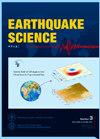Intraslab seismicity characteristics of northern Chile
IF 4.1
4区 地球科学
Q3 Earth and Planetary Sciences
引用次数: 0
Abstract
The Chilean subduction zone is one of the most seismically active regions globally, characterized by extensive intermediate-depth seismicity in the slab. In this study, we construct a new earthquake catalog for northern Chile using seismic waveforms assembled for the period of 2014−2019, from which 320,070 P-wave and 232,907 S-wave first arrivals are obtained for 25,763 earthquakes. Grid search location method NonLinLoc is applied to determine initial earthquake locations and double-difference location method is used to improve relative event locations. The distribution of earthquakes exhibits distinct patterns to the north and south of 21°S. There are many more earthquakes deeper than ∼150 km to the south of 21°S, while relatively fewer to the north. The intraslab earthquakes shallower than ∼80 km generally reveal a distinct double seismic zone, and the gap between the two seismic planes disappears at a depth of approximately ∼80 km, followed by a concentration of seismicity in the depth range of ∼80−150 km. In the deeper slab, there exist several seismicity clusters with distinct earthquake activities down to ∼300 km. These characteristics shown in slab seismicity are likely caused by different mechanisms and can be helpful for understanding the subduction process.
智利北部实验室内地震活动性特征
智利俯冲带是全球地震活动最活跃的地区之一,其特征是在板块中广泛存在中深度地震活动。在这项研究中,我们使用2014 - 2019年期间的地震波组合构建了智利北部的新地震目录,其中25,763次地震获得了320,070次p波和232,907次s波首次到达。采用网格搜索定位方法NonLinLoc确定地震初始位置,采用双差定位方法改进相对事件定位。地震分布在21°S以北和以南有明显的规律。在21°S以南,深度超过~ 150 km的地震更多,而在北部相对较少。浅于~ 80 km的岩内地震通常显示出明显的双地震带,两个地震面之间的间隙在约~ 80 km深度处消失,随后在~ 80 ~ 150 km深度范围内地震活动集中。在较深的板块中,存在几个地震活动群,在~ 300 km以下有明显的地震活动。这些板状地震活动的特征可能是由不同的机制引起的,有助于理解俯冲过程。
本文章由计算机程序翻译,如有差异,请以英文原文为准。
求助全文
约1分钟内获得全文
求助全文
来源期刊

Earthquake Science
GEOCHEMISTRY & GEOPHYSICS-
CiteScore
1.10
自引率
8.30%
发文量
42
审稿时长
3 months
期刊介绍:
Earthquake Science (EQS) aims to publish high-quality, original, peer-reviewed articles on earthquake-related research subjects. It is an English international journal sponsored by the Seismological Society of China and the Institute of Geophysics, China Earthquake Administration.
The topics include, but not limited to, the following
● Seismic sources of all kinds.
● Earth structure at all scales.
● Seismotectonics.
● New methods and theoretical seismology.
● Strong ground motion.
● Seismic phenomena of all kinds.
● Seismic hazards, earthquake forecasting and prediction.
● Seismic instrumentation.
● Significant recent or past seismic events.
● Documentation of recent seismic events or important observations.
● Descriptions of field deployments, new methods, and available software tools.
The types of manuscripts include the following. There is no length requirement, except for the Short Notes.
【Articles】 Original contributions that have not been published elsewhere.
【Short Notes】 Short papers of recent events or topics that warrant rapid peer reviews and publications. Limited to 4 publication pages.
【Rapid Communications】 Significant contributions that warrant rapid peer reviews and publications.
【Review Articles】Review articles are by invitation only. Please contact the editorial office and editors for possible proposals.
【Toolboxes】 Descriptions of novel numerical methods and associated computer codes.
【Data Products】 Documentation of datasets of various kinds that are interested to the community and available for open access (field data, processed data, synthetic data, or models).
【Opinions】Views on important topics and future directions in earthquake science.
【Comments and Replies】Commentaries on a recently published EQS paper is welcome. The authors of the paper commented will be invited to reply. Both the Comment and the Reply are subject to peer review.
 求助内容:
求助内容: 应助结果提醒方式:
应助结果提醒方式:


